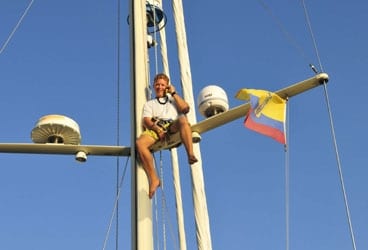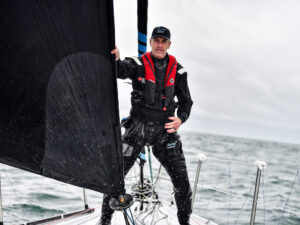
sat phones 368
We’ve sailed from Newport, Rhode Island, to Cartagena, Colombia, through the Panama Canal, down to Ecuador, out to the Galápagos Islands, and across the Pacific to Easter Island. Currently, we’re bound for French Polynesia and New Zealand. We have an SSB to connect with other cruisers on radio nets, but while preparing for this trip, we decided to forgo the expense of a Pactor modem or a handheld Iridium phone for email and phone calls home; instead, we invested our money in a broadband satellite system. We liked the idea of an always-on voice and data connection without the complexity of SailMail or Winlink HF radio connections.
We bought Iridium’s OpenPort system before we left. Since the Fleet Broadband system hadn’t yet been released, KVH was kind enough to supply the TrackPhone Fleet Broadband 150 system in Panama for evaluation. These sat-com systems have been our primary/only link to family and friends via email and phone calls and our primary source for weather information.
Iridium’s OpenPort and KVH’s Fleet Broadband 150 hardware packages are quite similar. They include an antenna dome that connects via a single power and signal cable to a belowdecks unit. The belowdecks unit has connections for power, antenna, Ethernet LAN, and an analog telephone jack.
The Iridium OpenPort antenna is a 22-inch-diameter by 9-inch-tall solid-state unit; the Fleet Broadband 150 has a 13.5-inch-diameter by 13-inch-tall stabilized antenna. The FB 150 comes packaged with an Internet Protocol telephone handset that connects via Ethernet cable and allows cellphone-like viewing and control of the system.
I based my evaluation upon five basic criteria: ease of installation, voice quality and service uptime, data speed, power consumption, and cost.
Installation
Both the OpenPort and the Fleet Broadband 150 have similar requirements for antenna placement, including a clear view of the sky and separation from radar. For most sailboats, this restricts mounting options to the spreaders. Before the trip, when the rig was down for inspection, I added port and starboard spreader mounts and ran cabling.
Installing the systems was quite easy. The self-install kit provided by Iridium was thorough and included printed manuals, all the hardware and bolts required, and even a full assortment of screws, wire-ties, and suppression ferrites that weren’t even called for in the instructions.
KVH relies on downloaded PDF manuals, and you must supply all extraneous hardware, but the instructions were easy to follow. Both systems require the thin antenna cables to be led from the antenna to a safe, dry location housing the belowdecks unit. This unit requires fused power connections (either 12- or 24-volt) and grounding before you connect the phone and computer cables. These two installations were so similar that neither system stands out, but Iridium gets kudos for including ancillary hardware and printed instructions. Installation is within the abilities of a savvy skipper and would be easy for a professional.
Voice Quality and Service Uptime
We rely on satellite communication first and foremost for weather and routing data, and to us, this is a safety issue. After I previously experienced problems with a Globalstar unit, service availability was a top concern for me. Satellite connections with both units seem to be available just about all of the time, although both systems experienced short outages within a few days of each other while in Panama City. This was likely due to some local interference in a busy, industrial city. Other than those two short episodes, we’ve not seen any problems with coverage from New England to Easter Island. Theoretically, both systems should have full coverage over our entire passage to New Zealand. Iridium, because of its satellites, has an advantage at very high latitudes, but we prefer relatively warm weather, so that’s of little concern to us.
We use these systems with a cordless phone, and we found that OpenPort voice quality is generally fine, similar to a cellphone, but occasionally we’ve experienced bad connections, echoing, or dropped calls. Hanging up and redialing usually solved these problems, but occasionally, if it became too frustrating, we resorted to making a call via Fleet Broadband instead. The FB 150 is similar in quality to a normal OpenPort connection but seems to be more consistent and doesn’t experience the echoes that OpenPort does on occasion. It once dropped a data connection, but never a voice call.
Voice quality over the phone included with the Fleet Broadband system is slightly better than over our cordless phone, but much of this may be due to the phone we use. As for any concerns about the stabilized FB 150 antennae losing the signal in a seaway, even in 10-foot seas on our 12-day crossing to Easter Island, the FB 150 held on to a strong signal. The OpenPort is solid-state, so sea state shouldn’t affect signal quality significantly and hasn’t in our testing.
Data Speed
I based my speed comparisons on Iridium and KVH plans of comparable cost. It could be argued that this is unfair as our OpenPort system is limited to 32 kilobytes per second (capable of up to a max of 128 kilobytes per second) due to our service plan; Fleet Broadband is capable of 150 kilobytes for a plan with a similar price. Since the cost to go with OpenPort’s premium service (boosting speed to 128 kilobytes per second) was quite high, I decided that plan cost would offer the most meaningful apples-to-apples speed comparison.
My testing found that on our boat, the FB 150 has a peak download speed of 160 kilobytes and upload speed of 39 kilobytes. The OpenPort achieved 33-kilobyte-per-second downloads and 25-kilobytes-per-second uploads. It’s impressive that both systems test at higher rates than they advertise. It’s also interesting to note that their upload performance is much more on par. This isn’t something that gets highlighted in their brochures.
Real-world comparisons using large email attachments and web pages found download speeds on the order of 75 percent of the peak test rates and upload speeds even further reduced due to the time delays of connecting to an email server. The speed of sending mail was nearly identical on both systems, but downloads were three to four times faster on the FB 150. In general, it’s clear that Fleet Broadband, given the service plans, is faster at downloads and really does allow browsing to approach what’s experienced at a good shoreside WiFi connection. OpenPort, with this service plan, at least, certainly works for browsing but reminds you of a dialup connection.
Power Consumption
Amp-hours are worth their weight in gold on a cruising boat, and most cruisers are very aware of their power consumption. Power usage was normalized to 12.0 volts for simplicity. At idle in a calm anchorage, the OpenPort measured a draw of 1.5 amps, while the FB 150 used just 1.2 amps. Telephone usage in a calm anchorage measured 1.7 amps for each, and at idle in an 8-foot seaway measured 1.4 amps for OpenPort and 1.5 amps for the FB 150. We were surprised that the FB 150 was not more of a power hog due to the stabilization motors in its antennae. Power utilization fluctuates more on the FB 150, particularly offshore, but when anchored in relatively calm harbors, the power consumption of the FB 150 may even be better than the solid-state OpenPort system, and neither is enough of a power hog to be of huge concern.
Cost
The Iridium’s OpenPort system retails for $5,800 and can be found for about $4,800; the KVH Fleet Broadband 150 retails for $7,500 and can be found for about $6,200, making for a real-world price difference of $1,400.
The typical published OpenPort fee is billed at $1.14 per minute for voice and $21.95 per megabyte of data, with fairly sharp discounts available with larger usage commitments. Prices vary based on supplier, so it pays to shop around. We found a package supplying 100 minutes of voice per month for $73 with no other commitments. Extra voice minutes are billed at 73 cents a minute, and data is billed at $13.50 per megabyte on an à-la-carte basis (limited to 32 kilobytes).
Fleet Broadband service is available at an à-la-carte cost of $1.49 per minute for voice ($1.89 to cellphones) and $13.50 per megabyte for data. Discounts are also available for committed usage. Conveniently, if you sign up for 12 months at a time, you can use your credit at any time during the year. If you only use your boat for part of the year or are planning to spend a month in a place with WiFi, you can bank time and use it throughout the year as needed. A beginner plan, called a “Season Pass,” costs $59 per month for any combination of 5 megabytes of data or 50 minutes of voice each month; this breaks down to $11.85 per megabyte of data or $1.19 per minute of voice. Overages are billed at those same rates.
As important as the billing rate is the billing increment, and this is something they don’t publish, so you’ll have to ask. Our OpenPort provider rounds to the next 0.01 megabyte ($0.14), but KVH rounds to the next 0.1 megabyte ($1.19) each time you connect. Some providers may round to a smaller increment but have a minimum per connection. KVH’s policy is apparently a recent mandate from Inmarsat, and KVH is working on changing this policy, so make sure you ask your potential suppliers about their data-billing increment. For our usage of connecting once or twice a day to download email, this caused a 50-percent increase in our data cost our first month. The solution is to leave the FB 150 data connection active and disconnect at the computer (either via a firewall, or simply by disabling the network adapter on your computer). The downside is that you then have to leave the FB 150 powered up all the time.
Both units have web interfaces to allow you to track usage, though the OpenPort page is easier to use because it lists all your totals in one place. The FB 150 interface requires you to look at data and voice usage separately and doesn’t provide totals, though it does provide per-connection details that OpenPort doesn’t, which are helpful for tracking costs.
While aware of utilization and airtime costs when cruising, we do send and receive text emails fairly freely, and we try to talk to family at home every week, even when we’re offshore. Sending and receiving several midsize text-only emails might cost 25 to 50 cents-a small price to pay to be connected with family and friends.
Except for rare urgent situations, however, we don’t use these sat-coms for web browsing, as surfing remains costly even with these systems. Remember, an average 1- to 1.5-megabyte webpage download will cost $10 to $20, so this is something most of us can’t afford to do very often. When push comes to shove, however, and you need additional weather or voyaging information or must transfer funds, check a balance, or make a reservation, paying $12 to $20 from paradise can feel like a bargain.
Conclusion
The realm of broadband Internet has reached the cruising world. Both the OpenPort system by Iridium and Fleet Broadband by KVH provide always-on connectivity at a fraction of the size and cost previously possible. Each has its advantages. OpenPort is less expensive, both for the hardware and for voice calls, while Fleet Broadband offers greater download speeds and better data pricing. Both units blow away stand-alone Iridium phones or other older technologies when it comes to data speeds and per-megabyte cost, and both allow fast email downloads and real use of the Internet to the extent that most of us can afford it. But I couldn’t identify a clear winner, and I suspect that each will find users based on individual priorities.
CW electronics editor Ben Ellison is taking the month off and has deferred to frequent Panbo contributor Gram Schweikert for this assessment of broadband systems.








